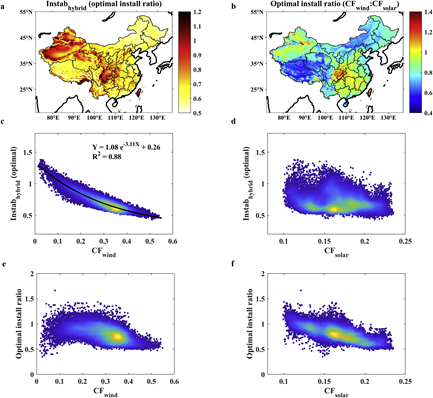
ABSTRACT
China has set ambitious goals to cap its carbon emissions and increase low-carbon energy sources to 20% by 2030 or earlier. However, wind and solar energy production can be highly variable: the stability of single wind/solar and hybrid wind-solar energy and the effects of wind/solar ratio and spatial aggregation on energy stability remain largely unknown in China, especially at the grid cell scale. To address these issues, we analyzed the newly 2007–2014 hourly wind and solar data, which have higher resolution and quality than those used in previous research. The stability of single wind/solar energy production clearly increased as the wind/solar energy capacity factor increased, and there were significant functional relationships between single wind/solar energy stability and the wind/solar energy capacity factor. Highly stable wind energy was concentrated in eastern Inner Mongolia, northeastern China, and northern China while highly stable solar energy was concentrated in the Tibetan Plateau, Inner Mongolia, and northwestern China. Different wind/solar ratios affected the stability of hybrid wind-solar energy through a unimodal relationship, allowing us to produce a map of optimal wind/solar ratios throughout China in order to minimize the variability of hybrid wind-solar energy production. At the optimal wind/solar ratio, the most stable hybrid wind-solar energy was concentrated in eastern Inner Mongolia, northeastern China, and northern China. The variability of single and hybrid wind/solar energy decreased as the aggregated area size increased, especially for wind-dominated energy systems. These results have important practical applications: (a) using the optimal wind/solar ratio to install simple hybrid wind-solar energy systems locally; (b) prioritizing the deployment of large-scale wind farms or centralized solar photovoltaic stations in regions with high hybrid energy stability; and (c) strongly promoting regional cooperation, such as breaking inter-provincial power grid barriers, to reduce the variability of hybrid wind-solar energy production and thus operational costs.
KEYWORDS
Wind energy; Solar energy; Energy stability; Install ratio; Spatial aggregation; China
JCR CLASSIFICATION
Q1
Renewable and Sustainable Energy Reviews
https://doi.org/10.1016/j.rser.2020.110151
